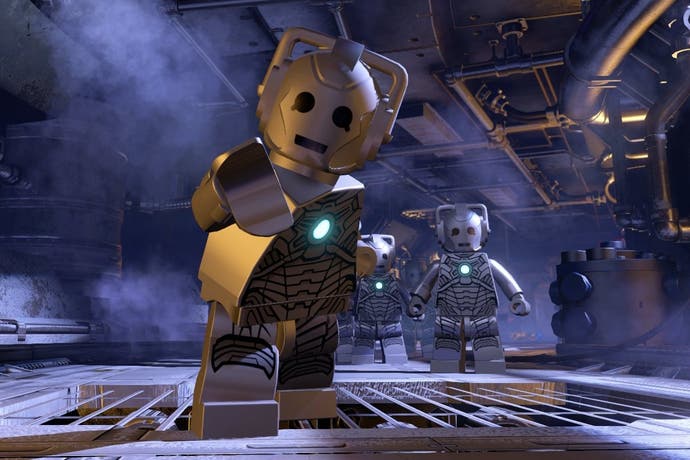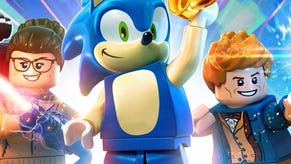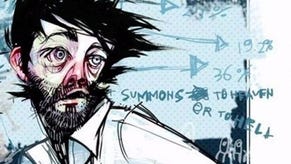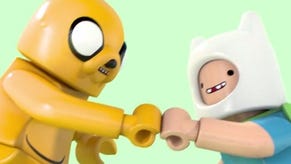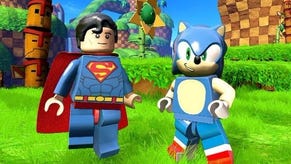Lego Dimensions review
Stud farm.
As both a parent and a gamer, I'm torn by Lego Dimensions.
It's an often wonderful game, one of the best in TT Games long-running series, and one that moves the familiar template forwards in clever and exciting ways. It's ingeniously written and structured too, juggling over a dozen character franchises with a confidence that masks the challenge of getting everything from Ghostbusters to Portal working together in a single story. It's also arguably the first game to truly deliver on the "toys to life" promise first made by Skylanders in 2011.
It's also a game that completely upends the boisterous generosity that has guided the Lego games to their blockbuster status though, and it requires a hefty financial investment if you and your kids want to access all of the extras and bonuses that have been a central part of the franchise over the last ten years.
The story sees the evil Lord Vortech - voiced with wheezing menace by Gary Oldman - embarking on a scheme to collapse many different Lego realities into a single realm that he can then rule over. To do this, he requires a foundational element from each world - an item or artefact unique to that reality. Along the way, he kidnaps Robin, Frodo and Captain Metalbeard, which in turn attracts the attention of Batman, Gandalf and Wildstyle from The Lego Movie, and alerts them to his plan.
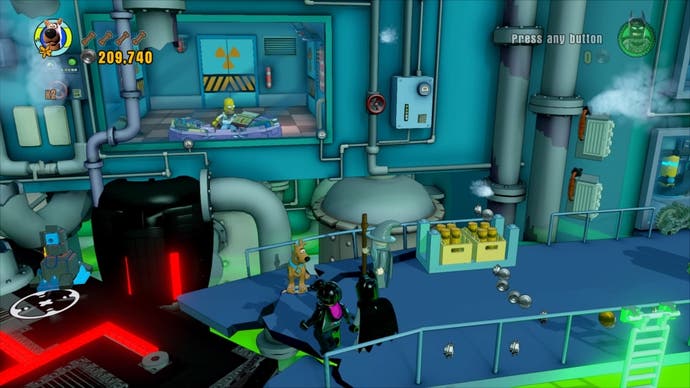
What follows is a giddy romp through fourteen stages, each of which represents a different realm for this unlikely trio to adventure through. You'll confront the Wicked Witch of the West at the end of the Yellow Brick Road, and battle your way through Springfield's nuclear power plant. You'll explore a ghostly mansion at the same time as Scooby Doo, and roam the spook-filled streets of New York as the Ghostbusters fight to restore order. You'll face Cybermen, Daleks and Weeping Angels while seeking assistance from Doctor Who, and try to escape the clutches of GLaDOS in the Aperture Science Labs. There's even an entire section which recreates classic Midway arcade games.
We've barely scratched the surface. This is a game that rejoices in its rich jumble of IP, yet never falls foul of the sort of mindless mash-up nonsense that drives sites like TeeFury. This isn't Calvin and Hobbes drawn as Optimus Prime and Bumblebee for no good reason - there's thought and wit in the way that characters are deployed and cross-pollinated. General Zod escapes from the Phantom Zone, for example, and so of course he appears in the Ghostbusters section. When the world of DC Comics bleeds into Middle-earth, it does so to bring The Riddler into proximity with Gollum, a fellow lover of puzzles and conundrums. Even if you never buy any of the other level or character packs, the story ensures you'll get to experience all of the properties along the way.
It should all result in a bewildering soup of influences really, but the Lego bricks provide a neat levelling effect, and allow seemingly incompatible properties to sit next to each other without looking out of place. They also make Dimensions the first "toys to life" game to use actual toys, rather than just statues. As lovingly designed and beautifully sculpted as the Skylanders and Disney Infinity figurines are, they're not particularly great to play with.
Here though, you use actual Lego minifigures and build real Lego kits. Pop them off their little NFC stands and kids can play with them, just as they would any other Lego toy. The construction process is even built into the game, with on-screen instruction booklets which walk you through the creation of the portal device used to bring characters into the game. As the game progresses, and you gather the elemental keystones that aid you in your quest, you're told to place those very same stones on the front of your own portal. The game doesn't know if you do it, of course, but it adds an element of interactive pantomime that supports the fiction.
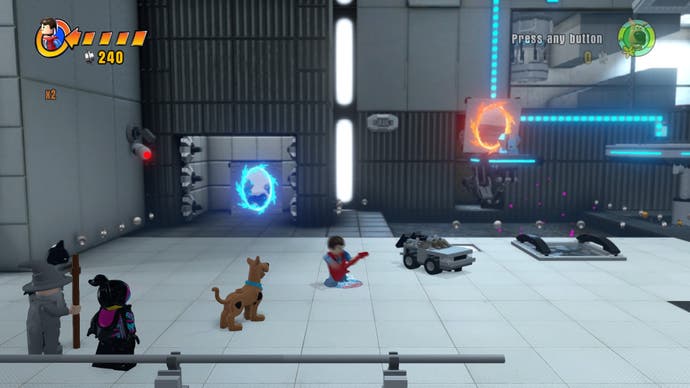
You're often asked to actually interact with the toys as well. The portal has spots for seven characters, vehicles or power-up objects at any given time, and it's divided into three zones. These are used for puzzle-solving purposes, as you move characters from one spot to another to break free of traps, or match colours to solve conundrums. Where rival titles are content to let the toys simply sit lifeless on top of their platform, Lego Dimensions uses them as ad hoc control inputs. The effect is an absolute joy, and the game doesn't really care how and when you mix up the characters either. Unlike Disney Infinity, which segregates its characters into their own story missions, and only allows crossovers in the freeform Toy Box mode, Lego Dimensions lets you use anything at any time.
Some of the actual stages are more compelling than others though. The Doctor Who section is great, and the encounter with the Weeping Angels is particularly clever. The Portal level is a spin-off worthy of Valve's own series, and even though you never get to play with a Portal gun, the section still manages to deliver all of the dry gallows humour and navigational puzzling that you'd hope for. The Simpsons stage, on the other hand, is a disappointment, and the power plant proves to be a remarkably generic location compared to other Springfield landmarks. Likewise, the Back to the Future stage is set in the series' 1885 era, and often feels like any other generic western game.
You only ever control Batman, Gandalf and Wildstyle as well, and your interactions with other iconic characters are largely restricted to cutscenes. In previous games, characters were introduced throughout the story, and unlocked at the end of each level. You could then replay each stage in Free Play mode, using the different abilities of this wider cast to access previously inaccessible areas and solve more puzzles, earning bricks and other bonuses in your quest towards 100% completion.
That's completely changed now, since the game doesn't give you new characters through gameplay alone. Although the different keystone powers go some way towards ensuring the lack of new abilities doesn't become tiresome, it does mean that the constant sense of accumulation and advancement is now absent. In Dimensions, you can complete the story using the three characters and vehicle included with the starter pack, and you can earn some of the gold bricks hidden in each level. You also get access to the three associated sandbox worlds - DC Comics, Middle-earth and The Lego Movie - in which you'll find lots more gold bricks, puzzles, checkpoint races and a few simple quests.

To go further than that, however, you'll need to start buying more toys, and it's here that the shift towards physical toys really starts eating into the genius design of the Lego games of old. If you ever got stumped in those, you always knew you'd unlock a character with an ability that would solve the problem later on. Now, all of those objects and interactions that you pass in the story mode are no longer invitations to jump back in for a second playthrough. Come the end of the story, you'll be no closer to having the characters or the abilities needed to tackle those mysteries - unless you make another visit to the shops, that is.
How many of those toys do you need to buy in order to be able to see everything in the game then? Well, that's the hard part to work out. Some obstructions, such as the shiny silver objects that must be blown up with explosives, can be tackled by dozens of different characters or vehicle combinations. Some draw from a much smaller pool of compatible characters though - puzzles involving rainbow items, for instance, can only by solved using one character: Unikitty from The Lego Movie.
If you want to ace the core game, it's simply not an option to buy the packs you want from the franchises you love. At some point you're going to have to - at a minimum - buy a basic character pack from a property you don't particularly care about, simply because you need the powers that are unique to those characters in order to access certain puzzle types.
In the game's defence, Skylanders and Disney Infinity aren't any different in this regard. Such limitations are, sadly, part and parcel of this kind of experience, and Lego Dimensions does go some way towards justifying its additional purchases by virtue of the fact you're also getting actual Lego kits to play with. Any parent who has a Lego-mad kid will know the wallet pain of buying even the smallest of kits these days, and there's a good chance you'd end up paying this much for Lego over the next year anyway. The constant reminders that you haven't got the toys you need still sticks in the craw though, especially given the generous expectations set by Lego games of the past.
That's why I'm torn by Lego Dimensions really. There's so much to love in this game, and there are so many moments of crossover lunacy that left me grinning from ear to ear. Yet even when supplied with a stack of additional characters and vehicles I still couldn't see everything in the game, and that's a real concern. The game itself is so enjoyable that it feels churlish not to recommend it, but parents should be aware that the recommendation comes with a serious caveat when it comes to the potential long-term cost.
